Shoreline ice can be dramatic and provide some really scenic photos, but it is usually short-lived. Marie and I used to live along the Lake Erie shoreline, in Rondeau Prov Park. In years when the temperatures got consistently low, there would be at least a covering of ice, sometimes as far as the eye could see. It might be only a few centimetres thick, and those were the best of times. I can remember listening at night, when a gentle wind would blow creating some slight swells of the water underneath. The ice would tinkle and groan, breaking up slightly with the ice plates creaking against one another. Then if a strong enough wind eventually occurred, and for long enough, those jagged ice plates would pile up along the shoreline, creating some dramatic sights. Here are a few of the best images I remember taking.
Most of the first set of photos were taken in March, of a fairly cold winter. This next photo shows a scene from about a week ago, taken just off the east beach by the Visitor Centre. While the first set of photos were taken with a short lens, even a wide-angle lens since the ice plates were right on the shoreline, this next one was taken with a telephoto lens since the shoreline ice was not as impressive.
In fact the ice right along the shoreline was fairly typical: slushy ice that had been washed ashore and piled higher and higher, but always fairly rounded and mounded. It is easy to walk along unlike the jagged ice plates shown above, but hardly as photogenic in my opinion.
At the right time, both of the season and the day, there can be some quite impressive sunrises along the shoreline. This next photo shows a sunrise photo I took several years ago near McGeachy Pond, just outside of Erieau.
As mentioned in previous posts, if there is open water, chances are you will find water birds, and that has continued to be the case along the Thames River at the west end of Chatham. The usual suspects continue, especially Mallard and Am Black Duck. A couple of female Hooded Mergansers are still hanging out there.
A nice surprise was to see this American Coot in the water at one point with a fish in its beak....
...and other times just standing around on the ice.
An even nicer surprise was to see this beautiful male Northern Pintail floating around on the water.
With the warmer weather and the run-off from melting snow being directed into the rivers and streams, I expect the small open water at the Thames that has been so attractive to waterfowl will get much more open quite quickly, and the ducks will disperse to many other spots.
In other wanderings of the past few days, I came across several flocks of Tundra Swans in the vicinity of the Ridgetown lagoons, as well as near Lake St. Clair.....
...unlike for this Cedar Waxwing, part of a flock of at least a dozen feeding on the berries of Red Cedars along the road by the Stefina Line pasture. I was shooting almost directly into the sun. Cedar Waxwings have not been very plentiful this winter, but a few have shown up in the last week or so.
This Eastern Screech Owl shows up in this cavity at Rondeau from time to time, but I only see it about once in every 6-8 times checking.
I was on the lookout for a Yellow-bellied Sapsucker, which has been seen periodically in the Rondeau campground even throughout this winter, but I haven't caught sight of it yet. This Red-bellied Woodpecker was not too interested in getting its photo taken.
With the generally snowy landscape, Wild Turkeys are more easily spotted, usually close by a woodlot for a quick escape if necessary.
And with the current warming trend, it is just a matter of time before things like American Woodcock will be present, but maybe only detected by their distinctive, nasal 'peent' heard off at the edge of a woods.




























































